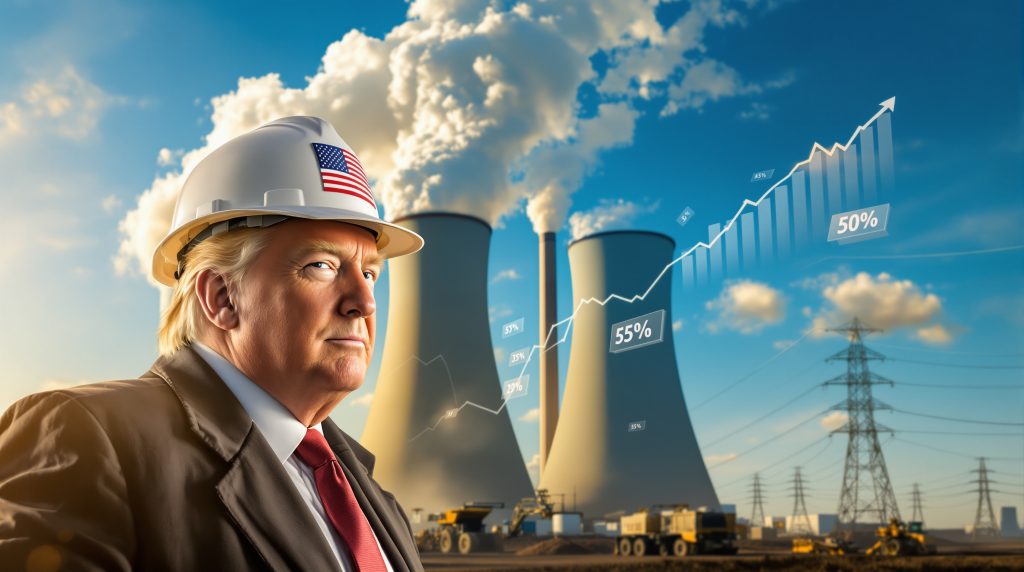The Resurgence of Coal: How Trump-Era Policies Could Reshape U.S. Energy Markets
The U.S. coal industry, which has experienced years of decline, may be on the verge of a significant comeback. Several converging factors are creating conditions for a potential surge in Peabody booming coal demand Trump era, with industry forecasts suggesting increases of up to 57% in the coming years. This resurgence represents a dramatic shift from the sector's long-term downward trajectory and raises important questions about America's energy future.
The Perfect Storm: Policy, Demand, and Capacity
The coal industry's optimistic outlook stems from a combination of supportive federal policies, rapidly increasing electricity demand, and significant untapped capacity in existing coal-fired power plants. These factors together create what some industry leaders view as ideal conditions for coal to reclaim market share in the U.S. energy mix.
The Trump Administration's Pro-Coal Agenda
Presidential policies have created a regulatory environment that actively supports coal power generation through several key initiatives:
- Blocking coal plant closures through executive action
- Designating coal as a critical mineral to streamline production
- Promoting federal coal lease sales on public lands
- Using emergency powers to maintain coal plant operations
- Reducing environmental compliance requirements for coal facilities
How Much Could U.S. Coal Consumption Actually Increase?
U.S. coal consumption stands at approximately 439 million tons in 2025, representing a modest 6.7% increase from 2024 levels according to the U.S. Energy Information Administration. However, this figure remains dramatically lower than coal's peak consumption of 1.13 billion tons in 2007.
The coal industry sees significant growth potential in the gap between current and historical usage patterns. Peabody Energy, one of America's largest coal producers, projects that increased demand could reach an additional 250 million tons annually in the coming years, potentially driving coal market transformation up by as much as 57%.
Current Coal Usage vs. Maximum Potential
The coal industry has identified a substantial gap between current operational levels and historical peaks:
| Metric | Current Value | Historical Peak | Potential Increase |
|---|---|---|---|
| Coal Plant Utilization | 42% (2024) | 72% (2008) | +30 percentage points |
| Annual Coal Consumption | 439M tons | 1.13B tons | Up to +250M tons |
| Electricity from Coal | 17% of generation | 49% of generation | Significant headroom |
This data illustrates the mathematical ceiling for potential growth, though energy analysts caution that reaching these levels would require a perfect alignment of market conditions and policy support.
The Mathematics of Maximum Utilization
Mark Spurbeck, Chief Financial Officer of Peabody Energy, has emphasized the "great untapped potential for existing U.S. coal plants." The company's growth projections assume that coal plants will boost their operational capacity to match historical utilization rates.
This theoretical maximum scenario assumes:
- No additional coal plant retirements
- Sustained policy support for coal generation
- Competitive coal pricing versus alternatives
- Sufficient transmission capacity to deliver coal-generated electricity
Industry analysts note that while these calculations represent the mathematical potential, real-world constraints may limit actual growth.
Why Is Electricity Demand Surging in the United States?
The fundamental driver behind potential coal growth is a projected 25% increase in U.S. electricity consumption through 2030. This unprecedented demand growth stems from several sources, creating pressure on the grid that existing generation capacity may struggle to meet.
Key Demand Growth Factors
-
AI and Data Center Expansion: The artificial intelligence revolution requires massive computing resources, with data centers becoming one of the fastest-growing electricity consumers in the country. Each new hyperscale data center can consume as much electricity as a small city.
-
Industrial Electrification: Manufacturing facilities are increasingly electrifying processes previously powered by direct fossil fuel combustion. New factories, particularly in sectors like semiconductor manufacturing and electric vehicle production, are significantly increasing industrial power demand.
-
Residential Electrification: American homes are adopting more electric appliances, heating systems, and electric vehicles, driving household consumption higher. The transition from gas to electric heating systems and the proliferation of EV charging infrastructure are creating new demand peaks.
-
Grid Reliability Concerns: Recent extreme weather events have heightened focus on baseload power generation capacity. The need for reliable power during extreme conditions has renewed interest in generation sources that can operate continuously regardless of weather conditions.
This combination of factors is creating what energy experts describe as an unprecedented surge in electricity demand, outpacing the rate at which new generation capacity is being added to the grid.
What's Preventing Natural Gas from Meeting This Demand?
Despite natural gas's dominance in recent power generation additions, several factors limit its ability to fully capitalize on growing electricity demand, potentially creating an opportunity for coal to fill the gap.
Natural Gas Constraints
-
Supply Chain Bottlenecks: Pipeline infrastructure limitations restrict natural gas delivery to power plants in key regions. Particularly in the Northeast and parts of the Midwest, insufficient pipeline capacity creates delivery constraints during peak demand periods.
-
Permitting Challenges: New natural gas plants face lengthy approval processes and local opposition. The timeline for developing new natural gas infrastructure has extended significantly, with permitting processes often taking years to complete.
-
Price Volatility: Natural gas prices have shown significant fluctuation, complicating long-term planning. Historical price spikes have occasionally made natural gas less economically attractive than coal for baseload generation.
-
Transmission Limitations: Getting electricity from gas plants to demand centers requires grid upgrades. In many regions, transmission infrastructure is insufficient to deliver power from areas with abundant natural gas to growing demand centers.
These constraints create a potential opening for coal plants, which already exist and could increase output with relatively minimal capital investment compared to building entirely new generation facilities. Furthermore, the latest natural gas trends show continued volatility in the market.
How Are Coal Plants Currently Operating?
The U.S. coal fleet has been running well below its technical capacity for years, creating substantial room for increased utilization without requiring new plant construction.
Current Coal Plant Operations
-
Average Capacity Factor: Coal plants operated at just 42% of their potential output in 2024, according to Peabody Energy data. This represents a significant amount of idle capacity that could theoretically be brought online.
-
Historical Comparison: This represents a significant decline from 2008 when plants operated at 72% capacity. During that period, coal plants were primary baseload generators running near their maximum sustainable output.
-
Idle Capacity: Many plants run only during peak demand periods or remain on standby. Some facilities operate seasonally or are kept in reserve status, operating only when electricity prices reach certain thresholds.
-
Regional Variations: Coal plant utilization varies significantly by region, with some areas maintaining higher dependence on coal generation. Plants in the Midwest and certain parts of the Southeast typically maintain higher capacity factors than the national average.
This underutilization creates the mathematical potential for significant increases in coal-fired generation without requiring new plant construction, simply by running existing facilities more frequently and at higher output levels.
What Are the Realistic Prospects for Coal's Resurgence?
While industry projections paint an optimistic picture, energy analysts offer more tempered expectations about coal's potential comeback. Many experts believe the 57% growth projection represents an idealized scenario rather than a likely outcome.
Expert Perspectives on Coal's Future
-
Theoretical Maximum vs. Reality: The 250 million ton demand increase represents a mathematical ceiling rather than a likely outcome. Andy Blumenfeld, director of data analytics at McCloskey by Opis, characterized it as "a theoretical maximum, if everything works perfectly. And they don't."
-
Competing Energy Sources: Renewable energy continues to expand rapidly with improving economics. Wind and solar capacity additions have consistently outpaced coal in recent years, with costs continuing to decline.
-
Long-Term Trends: Despite short-term increases, the overall trajectory for coal remains challenging. Environmental policies, corporate climate commitments, and economic factors continue to pose structural challenges to coal's competitive position.
-
Plant Economics: Many coal facilities face maintenance and operational challenges after years of reduced investment. Deferred maintenance and staffing challenges could limit the ability of some plants to significantly increase output.
The most realistic scenario may involve a modest increase in coal utilization rather than the dramatic surge suggested by the most optimistic projections, with significant regional variations based on local grid needs and existing infrastructure. Additionally, the potential Trump tariffs impact on energy markets could further complicate the outlook.
How Would Increased Coal Usage Impact Climate Goals?
A significant increase in coal consumption would have substantial implications for U.S. carbon emissions and climate commitments, potentially creating policy tensions and investment uncertainties.
Environmental Considerations
-
Carbon Emissions: Coal produces approximately twice the CO₂ emissions per unit of electricity compared to natural gas. Increasing coal generation by the projected 250 million tons would add approximately 500 million tons of CO₂ annually to U.S. emissions.
-
Climate Commitments: Increased coal usage would make meeting international climate pledges more difficult. The U.S. has committed to reducing greenhouse gas emissions by at least 50% below 2005 levels by 2030.
-
Environmental Justice: Communities near coal plants and mines often bear disproportionate pollution burdens. Increased coal production and combustion could exacerbate local air quality issues and other environmental impacts.
-
Regulatory Uncertainty: Future administrations could reverse pro-coal policies, creating investment risk. The cyclical nature of energy policy creates uncertainty for long-term capital allocation decisions in the coal sector.
These environmental considerations create significant uncertainty about the sustainability of any coal resurgence, particularly beyond the near term. Financial markets are increasingly factoring climate risk into investment decisions, which may limit capital availability for coal-related projects despite supportive federal policies. However, some companies are exploring decarbonisation benefits within the mining sector itself.
What Does This Mean for Coal Mining Companies?
For coal producers like Peabody Energy, the potential demand increase represents a significant business opportunity after years of challenging market conditions. A Michigan power plant that burns Peabody fuel recently had its shutdown plans blocked, providing a concrete example of policy shifts that could benefit the industry.
Industry Implications
-
Production Expansion: Mining companies could reactivate idled capacity and increase output. Many companies have maintained access to additional reserves that could be brought online if demand warrants.
-
Employment Growth: Higher production could create additional mining jobs in coal regions. Areas that have experienced economic challenges due to coal's decline could see some revival in mining employment.
-
Financial Recovery: Improved demand could strengthen balance sheets for coal producers. After years of financial struggles, including several high-profile bankruptcies, coal companies could use improved cash flow to reduce debt and reinvest in operations.
-
Investment Decisions: Companies must weigh short-term opportunities against long-term industry trends. The tension between potential near-term demand growth and longer-term structural challenges creates complex capital allocation decisions for coal executives.
Coal mining companies are approaching this potential opportunity with cautious optimism, recognizing that while near-term conditions may improve, longer-term challenges remain significant. Strategic decisions about mine reactivations, capital expenditures, and financial management will need to balance short-term market opportunities with longer-term industry uncertainties. The industry is also watching developments related to the Alaska energy policy shift for broader energy policy indications.
Conclusion: Will Coal's Comeback Materialize?
The coal industry's projection of up to 57% demand growth represents an optimistic scenario requiring several factors to align perfectly. While electricity demand is indeed rising dramatically and supportive policies are in place, structural challenges remain for coal's long-term prospects.
The most likely outcome appears to be a temporary boost in coal consumption rather than a fundamental reversal of the industry's long-term decline. However, even a modest increase would represent a significant deviation from the expected trajectory of U.S. energy markets and have important implications for electricity prices, carbon emissions, and energy security.
The coming years will reveal whether coal's potential resurgence becomes reality or remains primarily a mathematical possibility. The outcome will depend on the interplay of policy stability, electricity demand growth, natural gas market dynamics, renewable energy expansion, and grid infrastructure development.
FAQs About Coal's Potential Comeback
How much coal does the U.S. currently consume?
The United States consumes approximately 439 million tons of coal annually as of 2025, which is significantly lower than the peak consumption of 1.13 billion tons reached in 2007.
What percentage of U.S. electricity comes from coal?
Coal currently generates about 17% of U.S. electricity, down from nearly 50% at its peak in the early 2000s.
Why aren't coal plants running at full capacity?
Coal plants operate below capacity due to economic factors (cheaper alternatives), reduced electricity demand in some regions, and environmental regulations that have made coal less competitive.
How quickly could coal plants increase their output?
Many coal plants could increase output relatively quickly, within weeks or months, provided they have maintained their equipment and have access to sufficient coal supplies.
What would prevent coal from reaching the projected demand levels?
Continued expansion of renewable energy, natural gas price competitiveness, potential policy changes under future administrations, and coal plant retirements could all limit coal's resurgence.
Further Exploration:
Readers interested in learning more about trends in U.S. energy markets can also explore related educational content from the U.S. Energy Information Administration, which provides regular updates on coal consumption, electricity generation, and energy market forecasts.
Want to Capitalise on the Next Major Mining Discovery?
Stay ahead of the market with Discovery Alert's proprietary Discovery IQ model, which provides real-time notifications when significant mineral discoveries are announced on the ASX. Explore why historic discoveries can generate substantial returns by visiting our dedicated discoveries page and begin your 30-day free trial today.




